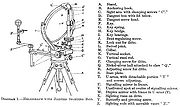Heliograph
|
| Heliograph |
|---|
History
Function
The Signals heliograph is a daytime visual signaling instrument for sending Morse code as flashes of sunlight. It uses a 3" or 5" mirror mounted on a tripod and an optional second mirror added if the sun was behind the signaller. The main mirror is mounted to a four-bar tilting mechanism that is operated in the same fashion as a telegraph key. When the key is depressed, the mirror reflects sunlight at the receiving station, and when the key is released, the beam falls off of the receiving station. A skilled heliograph operator was expected to transmit and receive at 8 words per minute.
From a 1922 manual:The heliograph, 5-inch, Mark V, has an exposed mirror surface of 5 inches and wieghs, in its case, 8 lbs. Its range in favourable atmosphere is 70 miles. Its use is very dependent on climatic conditions because for practical purposes it can only be used when the sun is shining. It has the great advantage of secrecy because its signals can only be read within a few yards of the station into which it is directed. Its chief advantages are portability, range, secrecy, rapidity of sending, and ease in opening communication owing to the flash being so readily noticeable. Its disadvantages are the need for continual training and practice to obtain good results, its dependence on the sun and the delicacy of some of its adjustments which make it liable to become unserviceable unless carefully handled.
Components
Related Pages
- No related pages at this time
Related Items
See Also
References
.

























